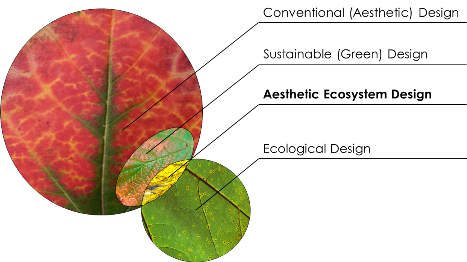What is ecological landscape design?
When I talk to most people about landscape design, they think of planting flowers and cutting grass. While the fields of landscape design and architecture span far beyond landscape maintenance, the notion of ecological landscape design is even more foreign.
Most folks, while perhaps unaware of the term, are in contact with the work of landscape designers and architects every day. Their work shapes all land surrounding the built environment. It defines the human experience with the land in these areas.
In this rapidly changing world, the need for an ecological approach to land use is becoming ever more important. This is where the notion of an ecological landscape design comes into play.
For the purposes of what I describe on this site, I have defined ecological landscape design as follows:
Ecological design is a design process and implementation that takes primary consideration of the natural resources of the site over the human setting and experience.
As opposed to conventional or aesthetic design, where the primary focus is on the human experience (i.e. human over nature), ecological design has a primary focus on the natural ecosystem (i.e. nature over human).
Of course, there is a broad array of application between aesthetic and ecological, but most designs fall more along one side or the other as opposed to a combination of the two.
So why is ecological design so important?
We as a species are beginning to realize that we are quickly becoming the most significant influencer of change on this planet. While oceans, glaciers, wind, and water once held this role, humans now disperse synthetic chemicals throughout the oceans and atmosphere, level mountains, decimate forests, and create other mountains with refuse.
No, I’m not going to talk about how the world is about to be overpopulated and about to end and all of the polar bears will die. Don’t get me wrong, I think we are on a precipice with how we treat our planet, but that’s not to be debated here.
Instead, I want to show you that the human race has indeed dramatically changed the surface of this planet. And this is a call for more responsible behavior.
A 2012 assessment done by the Geological Society of America showed that:
>50% of Earth’s ice-free land area, has been directly modified by human action involving moving earth or changing sediment fluxes. Many of these activities have indirect consequences well beyond the area directly affected. Converting land to agriculture leads to local extinctions of biota in adjacent areas, the insecticides and herbicides used diffuse into the surroundings, killing non-target species, and fertilizers foul our streams and rivers, leading to dead zones in the ocean.1
In short, humans have altered greater than 50% of our land surface in one way or another. We cannot assume that this will have no negative effect. The key is for us to be as conscious as possible with the land we have already modified to mitigate detrimental effects, while preserving the remaining 50%.
From an assessment done by the Earth Policy Institute, total forested area covered approximately 27% of existing land surface in 2005. In pre-industrial times, 40% of the land surface was forested.2,3 That’s a 33% reduction in the original amount of forest. Many debate how detrimental is this deforestation.
Rather than debate this further, let’s look at it from a different perspective. Mature forests are considered one of the most buffered ecosystems in existence. What does this mean? It means that forests are regulators. They balance temperature, moisture, wind, organic matter, and organisms, to name a few.
Consider this: Imagine you are walking through a forested park on a nice stroll. But it happens to be the hottest day of the summer. You are hot. But then you get to the end of the trail and have to walk across the parking lot to your car. Wow. Now you want to walk back into the forest and down by that creek where it was nice and cool.
Now imagine you take all the forests like that and cut down 33% of them. That’s a lot of buffering capacity.
Poof.
Gone.
It is time for us to be more responsible for those places we have altered the natural landscape. That is what ecological design does.
Think of it from one more angle
Surrounding the built environment, there is an innate human desire to alter the landscape to look appealing and fit our needs. We call this form and function. This process often ignores the needs of the land as well. Yet the more we integrate or mimic the natural environment in this landscape, the greater the effect upon maintenance, the sense of ‘place,’ and the greater connection we feel to nature.
In a review article on urban ecological design, the authors stated the benefit of integrated design well:
Urban ecosystems include four broad kinds of components – organisms, a physical setting and conditions, social structures, and the built environment – all interacting with one another. The interactions take the form of flows of information, matter, energy, and organisms. Landscape designs and management strategies that are aimed at one or two of these components or interactions, in reality have the potential to affect them all. Landscape designs that acknowledge and work with the connections between the social, biological, physical, and built components of the system are much less likely to produce unintended negative consequences, and are more likely to contribute to ecological sustainability. Furthermore, enhanced quality of urban life depends on all components of the urban ecosystem, not just some of them.4
In short, there is a measurable and marked benefit by incorporating ecological design into the common practice of urban design.
Thus, ecological design is equally – if not more – important than conventional or aesthetic design when it comes to a truly sustainable design.
Aesthetic Ecosystem design is the holistic incorporation of both aesthetic design and ecological design for maximum human and natural benefit. No longer does human and nature need to be at odds. Instead, we can use our power of knowledge and understanding to work with and capitalize upon natural systems in a way that appeals to the senses and evokes the spirit.
Now that we understand what ecological design is about, learn more about integrating ecological principles and aesthetics with aesthetic ecosystem design!
Key Drivers for Ecological Design
- Growing realization of limited resources
- Long-term cost effectiveness
- Better integration into biosphere
- Low-maintenance
- Increased human-nature connection
- Long-term solutions
Sources:
1. Land Transformation by Humans: A Review, Geological Society of America (GSA). Aug 16, 2012 //www.geosociety.org/
2. Earth Policy Institute //www.earth-policy.org/indicators/C56
3. Global Forest Resources Assessment, 2005 Food and Agriculture Organization (FAO)
4. Cadenasso, M.L. and S.T.A. Pickett. 2008. Urban principles for ecological landscape design and management: Scientific fundamentals. Cities and the Environment 1(2):article 4, 16 pp.
Image Credits:
Flickr: Chris Waits, Francesca Cappa, Norbert Reimer, Sharon Mollerus



